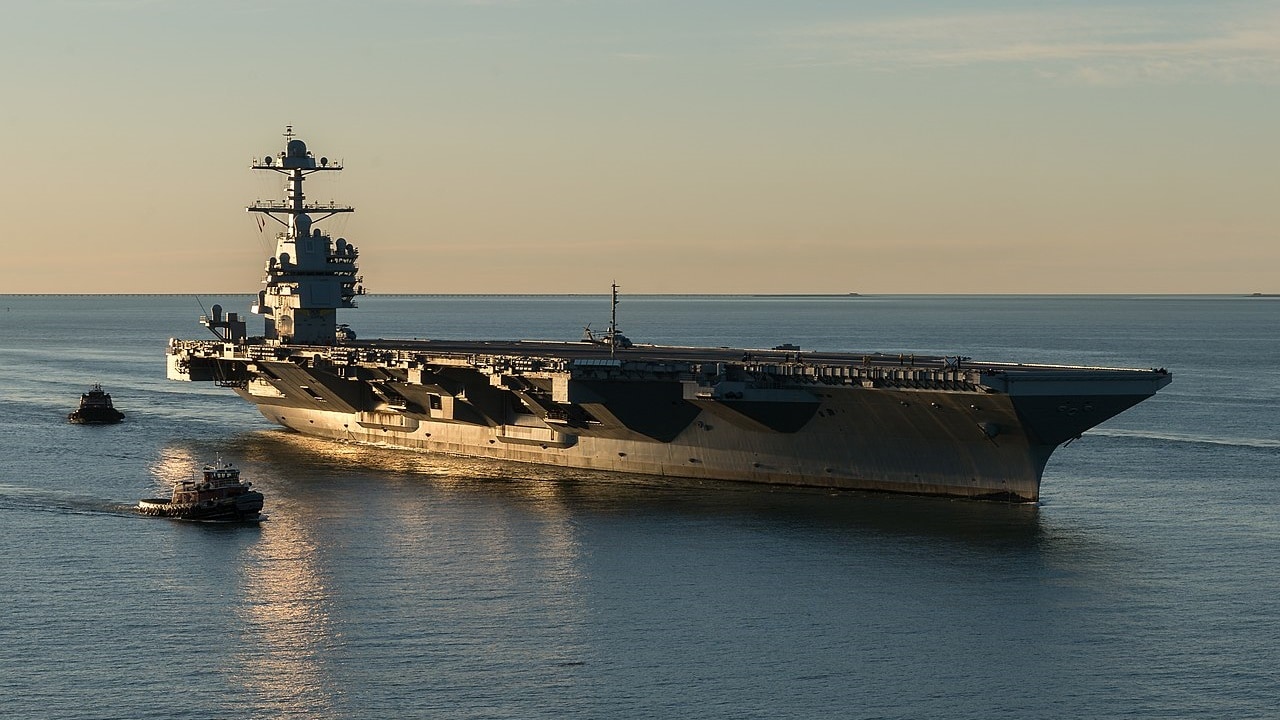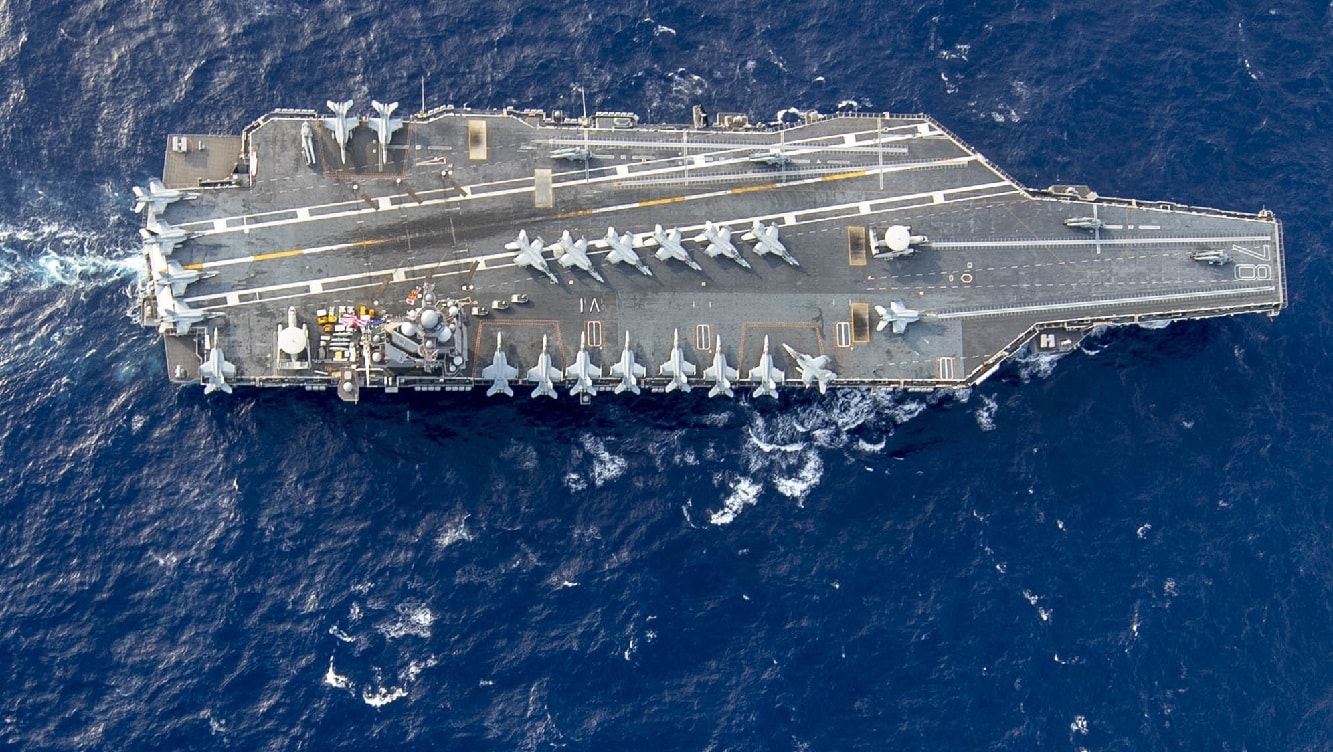That 1 Word: EXPENSIVE – The Ford-class aircraft carrier program has been monumentally expensive – starting with the final cost of the USS Gerald R. Ford which rang up at $13.3 billion dollars.
The USS John F. Kennedy was procured at $12.7 billion, and the USS Enterprise cost will be about $12.8 billion. The ships were supposed to be less expensive as they were constructed and came online. That has been partially true.
Due to these gargantuan costs for procurement (and this doesn’t include operating or maintenance costs), it is necessary to take a deeper look at why they are so expensive.
Are the New Technologies Worth It?
The cost growth has been stupendous. To its credit, the Navy has tried to control these ballooning expenses.
Still, it has been difficult due to the new technologies in the Ford-class, such as the Electromagnetic Aircraft Launch System (EMALS).
The Cost-cutting Conundrum
Congress has been concerned about the Ford-class program’s schedule slips and cost overruns.
Lawmakers have been worried about imposing cost caps to quell the costs, but the legislators do not want to be seen as obstructing such important ships needed for future combat in Europe or East Asia.
At Least 20 percent Cost Growth Among the Three Aircraft Carriers
Cost growth has been significant.
Since the FY2008 budget when the Ford-class was first procured, growth has accelerated among the Ford, Kennedy, and Enterprise to the tune of 27.0 percent, 38.2 percent, and 19.6 percent, respectively.
The Navy even had to request more dollars to keep the ship’s construction on time. That meant an extra $2.8 billion “Cost to Complete” expenses.
The Navy Low-balled Cost Estimates
Since the Ford-class vessels were new designs with advanced technology, it was difficult for the Navy to estimate costs. The initial estimates were absurdly low, and the cost growth has frustrated several members of the House and Senate Armed Services Committees.
The Nimitz-class carriers were much easier to project when it came to estimating expenses.
New Systems Have Ballooning Costs
The biggest hurdles for the Gerald R. Ford were the new systems such as the aforementioned AMALS, plus the new airplane arresting system known as the Advanced Arresting Gear (AAG), and the ship’s number one radar system, called the Dual Band Radar (DBR).
One thing the Navy did that was helpful to oversight policymakers was calculating the risk of cost over-runs. This made the price creep more palatable, but seeing how much the Ford-class would cost was still frustrating.
In June 2019, the Navy “estimated that the risk of future cost growth on CVNs 79, 80, and 81 were 64 percent, 78 percent, and 80 percent, respectively,” according to the Congressional Research Service.
One Way to Cut Costs
For the John F. Kennedy, the Navy decided one way to cut the budget was to spend less on the Dual Band Radar. The maritime service branch also wanted to make new arrangements for construction.
The John F. Kennedy would strive to “achieve a higher percentage of outfitting of ship modules before modules are stacked together to form the ship; achieve ‘learning inside the ship,’ which means producing similar-looking ship modules in an assembly line-like series, so as to achieve improved production learning curve benefits in the production of these modules; and more economical ordering of parts and materials including greater use of batch ordering of parts and materials, as opposed to ordering parts and materials on an individual basis as each is needed,” according to the Congressional Budget Office.
These cost-cutting measures should work well on the John F. Kennedy, and the Navy should be given credit for acknowledging the high price and figuring out how to save money on construction.
For the Enterprise, the Navy and its defense contractors for the carrier are also devising ways to cut costs in construction. Lessons learned on the Ford inform builders on how to best go about business without schedule slips and cost overruns.
One such lesson Defense News found “relates to crane lifts of large modules or supermodules. Given the immense size of aircraft carriers, the workforce builds the steel framing for segments of the ship, which can then be outfitted with pipes and cables. These modules are then lifted by crane and put into place on the hull.”
The contractor figured out how to make supermodules that needed less lift, resulting in fewer cranes. This saved money by cutting the number of expensive crane operators. This technique is small, but Congressional members will approve of such innovative thinking.
The Ford-Class Will Never Be a Cheap Aircraft Carrier
The Navy and defense contractors have a long way to go before they can declare victory over the cost overruns and schedule slips of the Ford-class carriers.
Workers are clearly looking for ways to cut expenses, but are they incorporating enough new ideas to save money? The example with the cranes and supermodules is a good one, but will these actions really cut significant amounts of funding?
One good thing about the whole program is the high level of eagle-eyed Congressional and media scrutiny about the costs. Analysts at 19FortyFive have been following the Ford-class carriers for years and have looked closely at the expenses. These aircraft carriers are needed badly, but the money spent has been sky-high. There are additional worries about maintenance and operating costs they will incur when the operational tempo goes higher.
What Happens Next?
The new Secretary of the Navy nominee, John Phelan will be hauled up in front of the defense policy committees on Capitol Hill to figure out ways to cut costs.
This could come from less complex technologies for the new radar and improved construction techniques that the workers can employ. It is time for the Ford-class program administrators to take cost-cutting seriously.

Ford-Class Aircraft Carrier. Image Credit: Creative Commons.
Growth of expenses is the number one problem for the new carriers, and it will take the Navy command structure, defense contractors, workers, and policymakers to band together to get this job done.
About the Author: Dr. Brent M. Eastwood
Brent M. Eastwood, PhD, is the author of Don’t Turn Your Back On the World: a Conservative Foreign Policy and Humans, Machines, and Data: Future Trends in Warfare, plus two other books. Brent was the founder and CEO of a tech firm that predicted world events using artificial intelligence. He served as a legislative fellow for U.S. Senator Tim Scott and advised the senator on defense and foreign policy issues. He has taught at American University, George Washington University, and George Mason University. Brent is a former U.S. Army Infantry officer. He can be followed on X @BMEastwood.

